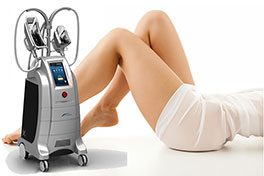estetikland
Updated on December 11th, 2023
Ana sayfa » Medical Esthetic » CoolSculpting
CoolSculpting is is a body contouring treatment that freezes fat cells at -5 to -10 degrees Celsius, causing them to die and be eliminated naturally by the body.
This method is known as a non-surgical fat reduction treatment because it does not damage the skin or surrounding tissues while applying cold energy directly to the fat layers under the skin.
Başlıklar
ToggleThis treatment is not used for general weight loss, but to reduce stubborn fat deposits in specific areas. Research on the effectiveness and safety of cold lipolysis suggests that the procedure may be effective for certain individuals, but this treatment is not suitable for everyone.

The basis of cold lipolysis (known commercially as “CoolSculpting“) dates back to some observations made in the 1970s. During this period, Drs. R. Rox Anderson and John Parrish studied a phenomenon called “popsicle panniculitis”. This is when children experience inflammation and reduction of fatty tissue in their cheeks after eating ice cream.
Anderson and Parrish realized that cold selectively affects fat tissue and can kill fat cells without damaging other surrounding tissues. This observation led to the idea that cold, when applied in a controlled manner, could selectively target fat cells and kill them without harming other tissues, which formed the basis of cold lipolysis treatment.
Thus, as a result of these observations and research, CoolSculpting, a non-invasive fat reduction method, was developed and commercially available.
Since CoolSculpting is based on the principle of freezing fat cells at a certain temperature level, the skin is protected from side effects such as cold bites and cold burns through the membrane with antifreeze properties. CoolSculpting, which works based on the principle of vacuuming, deforms the fat cells that it cools to -10 degrees by heating them to +10 degrees with a shock effect. Approximately 2 weeks after the 1-hour procedure, fat cells are excreted from the body through metabolic pathways (urine or sweat).
Results may start to be noticeable within a few weeks, but it can often take several months to see full results. The procedure can usually reduce fat cells in a given area by about 20-25%.
In order for the cold lipolysis application to be most successful, the treatment should be supported by consuming plenty of water, eating properly and healthily, and doing sports if possible. Thus, the success rate of cold lipolysis will increase and the regional thinning effect will be more permanent.
The areas where CoolSculpting is frequently applied, which provides the opportunity to intervene from the largest areas to the smallest areas thanks to its three different heads;
These are common areas where CoolSculpting is commonly performed, but the treatment can also be applied to other areas depending on individual needs and goals.

CoolSculpting is generally considered a safe method, but it can cause side effects in some individuals. These side effects are usually temporary and short-lived and may disappear within a few days or weeks after treatment.
Here are some potential side effects of CoolSculpting:
Most of these side effects are temporary and may disappear on their own. However, it is important to contact a health professional if you experience any complications or prolonged discomfort.

People with severe liver and kidney disease, umbilical hernia, cold urticaria, cancer and AIDS disease, uncontrolled diabetes, low blood protein disease, skin diseases such as psoriasis, cardiovascular disease are not suitable candidates for CoolSculpting. In addition, pregnancy and breastfeeding periods and the presence of a pacemaker are also obstacles for CoolSculpting.
Updated on December 11th, 2023